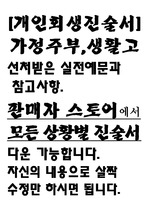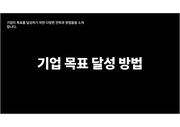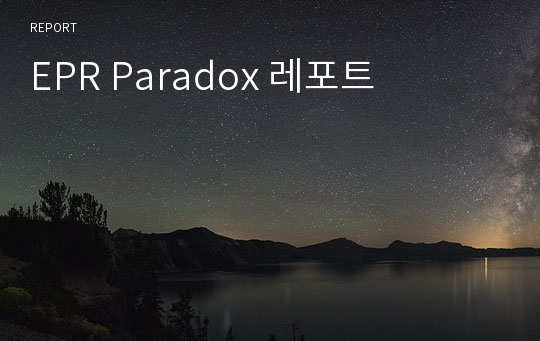목차
1. EPR Paradox Paper3. 벨의 실험
4. 결론
5. 참고문헌
본문내용
완전한 이론에는 실재의 각 요소에 대응하는 요소가 있다. 물리적인 양의 실재에 대한 충분조건은, 계를 교란시키지 않고도 확실하게 그것을 예측할 수 있는 가능성이다. 양자역학에서는 비가환 연산자 noncommuting operator가 기술하는 물리적 양들의 경우에 하나에 대한 지식이 다른 하나에 대한 지식을 배제한다. 그렇게 되면 (1) 양자역학에서 파동함수에 의해 주어진 실재에 대한 기술이 완전치 않거나 아니면 (2) 이 두가지 양들은 동시에 실재일 수가 없다. 전에 상호작용한 바 있는 다른 계에서 행해진 측정(값)에 근거해서 어떤 한 계에 관한 예측을 하는 문제를 고려해 보면,<중 략>
아인슈타인은 보어의 초기 업적은 높이 인정했지만, 양자 물리학이 미시세계를 이해하기 위해서 꼭 필요한 새로운 물리학이라는 보어의 주장을 받아들이지 않았다.
아인슈타인은 대상의 물리적인 상태는 측정과는 관계없이 객관적으로 존재하며 우리가 서로 다른 측정을 통해 다른 성질을 확인하는 것은 우리의 실험이 대상의 모든 성질을 파악할 수 있을 만큼 완전하지 못하기 때문이라고 주장했다.
아인슈타인과 슈뢰딩거를 비롯한 많은 과학자가 가장 격렬하게 비판한 내용 중의 하나가 불확정성의 원리였다.
코펜하겐 해석에 의하면 우리가 어떤 실험 결과를 얻을 수 있는지를
<중 략>
아인슈타인은 우주의 모든 사건은 물리 법칙으로 예측 가능하다고 확신하고 있었다. 자연의 법칙을 완전히 이해하고 있으면서 동시에 현재 상태를 정확히 알고 있다면 미래에 일어날 모든 사건을 정확하게 예측할 수 있어야 한다는 것이 그의 생각이었다. 따라서 그는 자연법칙에 확률을 개입시키는 것을 극도로 싫어했다. 이런 그의 생각은 “신은 주사위 놀이를 하지 않는다”라고 한 말에서 잘 나타나 있다.
실제로 그가 했던 말은 다음과 같다 “신이 가지고 있는 카드를 훔쳐보기는 어려운 듯싶다. 그러나 신이 텔레파시를 이용해서 주사위 놀이를 한다는 것은 한순간도 믿을 수가 없다”
참고 자료
A. Einstein, B. Podolsky and N. Rosen, “Can Quantum Mechanical Description of Physical Reality Be Considered Complete?” Physical Revies 47 (1935), 777-780Bacciagaluppi, G. and A. Valentini, 2009, Quantum Theory at the Crossroads: Reconsidering the 1927 Solvay Conference, Cambridge: Cambridge University Press.
Baggott, J., 2004, Beyond Measure: Modern Physics, Philosophy and the Meaning of Quantum Theory, Oxford: Oxford University Press.
Bell, J.S., 1964, “On the Einstein-Podolsky-Rosen Paradox”, Physics, 1:195-200, reprinted in Bell 1987.
, 1987, Speakable and Unspeakable in Quantum Mechanics, New York: Cambridge University Press.
Beller, M., 1999, Quantum Dialogue: The Making of a Revolution, Chicago: University of Chicago Press.
Bohm, D., 1951, Quantum Theory, New York: Prentice Hall.
Bohm, D., and Y. Aharonov, 1957, “Discussion of Experimental Proof for the Paradox of Einstein, Rosen and Podolski”, Physical Review, 108:1070-1076.
Bohr, N., 1935a, “Can Quantum-Mechanical Description of Physical Reality Be Considered Complete?”, Physical Review, 48: 696-702.
, 1935b, “Space and Time in Nuclear Physics”, Mss 14, March 21, Manuscript Collection, Archive for the History of Quantum Physics, American Philosophical Society, Philadelphia.
, 1939, “The causality problem in atomic physics” in Bohr, 1996, pp. 303-322.
, 1996, Collected Works, Vol. 7, Amsterdam: North Holland.
Born, M., (ed.), 1971, The Born-Einstein Letters, New York; Walker.
De Raedt, K. et al, 2007, “A Computer Program to Simulate Einstein?Podolsky?Rosen?Bohm Experiments with Photons”, Computer Physics Communications, 176: 642-651.
Dickson, M., 2004, “Quantum Reference Frames in the Context of EPR.” Philosophy of Science 71: 655-668.
Einstein, A. 1936, “Physik und Realit?t”, Journal of the Franklin Institute, 221: 313-347, reprinted in translation in Einstein 1954.
, 1954, Ideas and Opinions, New York: Crown.
Einstein, A., B. Podolsky, and N. Rosen, 1935, “Can Quantum-Mechanical Description of Physical Reality Be Considered Complete?”, Physical Review, 47:777-780.
Fine, A., 1996, The Shaky Game: Einstein, Realism and the Quantum Theory, 2nd Edition, Chicago: University of Chicago Press.
, 1982a, “Hidden Variables, Joint Probability and the Bell Inequalities”, Physical Review Letters, 48: 291-295.
, 1982b, “Some Local Models for Correlation Experiments”, Synthese 50: 279-94.
, 2007, “Bohr's Response to EPR: Criticism and Defense”, Iyyun, The Jerusalem Philosophical Quarterly 56: 31-56.
Howard, D., 1985, “Einstein on Locality and Separability.” Studies in History and Philosophy of Science 16: 171-201.
Halvorson, H., 2000, “The Einstein-Podolsky-Rosen State Maximally Violates Bell's Inequality”, Letters in Mathematical Physics, 53: 321-329.
Halvorson, H. and R. Clifton, 2004, “Reconsidering Bohr's Reply to EPR.” In J. Butterfield and H. Halvorson, eds., Quantum Entanglements: Selected Papers of Rob Clifton, Oxford: Oxford University Press, pp. 369-393.
Held, C., 1998, Die Bohr-Einstein-Debatte: Quantenmechanik und Physikalische Wirklichkeit, Paderborn: Sch?ningh.
Hooker, C. A., 1972, “The nature of quantum mechanical reality: Einstein versus Bohr”, in R. G. Colodny, ed., Paradigms and Paradoxes, Pittsburgh: University of Pittsburgh Press, pp. 67-302.
Jammer, M., 1974, The Philosophy of Quantum Mechanics, New York: Wiley.
Larsson, J.-A., 1999, “Modeling the Singlet State with Local Variables”, Physics Letters A, 256: 245-252.
Larsson, J.-A. and Gill, R. D., 2004, “Bell's inequality and the coincidence-time loophole”, Europhysics Letters 67: 707?713.
Malley, J., 2004, “All Quantum Observables in A Hidden-Variable Model Must Commute Simultaneously”, Physical Review A 69, 022118:1-3.
Sauer, T., 2007, “An Einstein manuscript on the EPR paradox for spin observables”, Studies in History and Philosophy of Modern Physics 38: 879-887.
Schilpp, P.A., (ed.), 1949, Albert Einstein: Philosopher-Scientist, La Salle, IL: Open Court.
Schlosshauer, M., 2007, Decoherence and the Quantum-to-Classical Transition, Heidelberg/Berlin: Springer.
Schr?dinger, E., 1935a, “Die gegenw?rtige Situation in der Quantenmechanik”, Naturwissenschaften, 23: 807-812, 823-828, 844-849; English translation in Trimmer, 1980.
Schr?dinger, E., 1935b. “Discussion of Probability Relations between Separated Systems”, Proceedings of the Cambridge Philosophical Society, 31:555-562.
Szabo, L. and A. Fine, 2002, “A Local Hidden Variable Theory for the GHZ Experiment”, Physics Letters A, 295: 229-240.
Trimmer, J. D., 1980, “The Present Situation in Quantum Mechanics: A Translation of Schr?dinger's ‘Cat Paradox’ Paper”, Proceedings of the American Philosophical Society, 124: 323-338
von Neumann, J., 1955, Mathematical Foundations of Quantum Mechanics, trans. Robert T. Geyer, Princeton: Princeton University Press.
Whitaker, M. A. B., 2004, “The EPR Paper and Bohr's Response: A Re-Assessment”, Foundations of Physics 34: 1305-1340.
Winsberg, E., and A. Fine, 2003, “Quantum Life: Interaction, Entanglement and Separation”, Journal of Philosophy, C:80-97






























